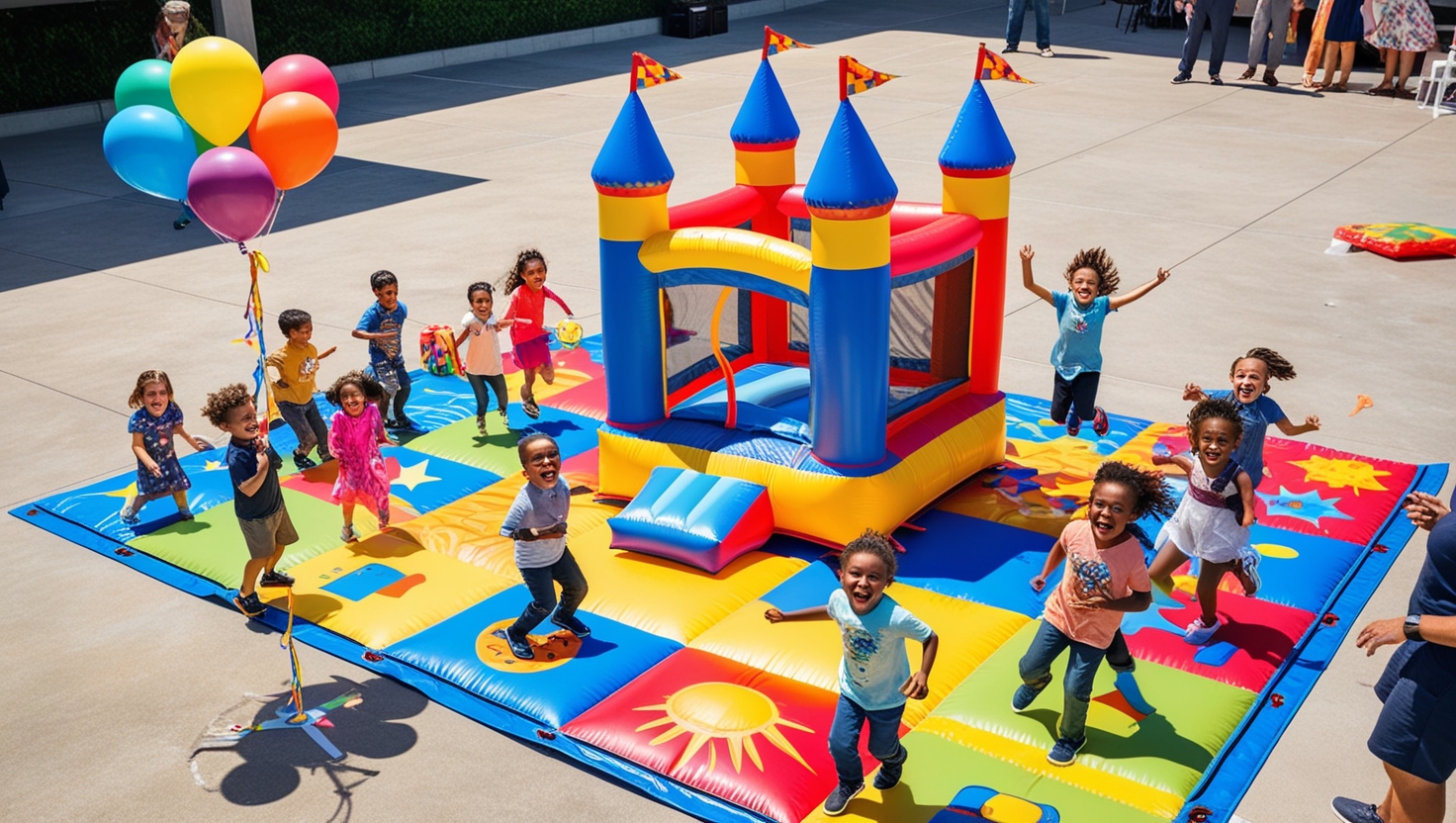
All you want to know about us
Click here to share this article

Can you set up a bouncy castle on concrete? Yes, bouncy castles can be safely installed on concrete surfaces with proper safety measures and anchoring techniques in place. Are you planning to set up a bouncy castle for your next event but worried about concrete surfaces? You're not alone. Many parents and event planners face this common dilemma when choosing the perfect spot for inflatable fun. The good news is that with the right precautions and setup methods, concrete can be a suitable surface for your bouncy castle. From using protective ground covers to implementing proper anchoring systems with sandbags or water weights, safety is achievable on hard surfaces. In this comprehensive guide, we'll walk you through expert-approved safety measures, essential setup techniques, and crucial considerations to ensure your bouncy castle installation on concrete is both secure and enjoyable. Let's bounce into the details of creating a safe play environment for your little ones.

Key Takeaways:
- Concrete surfaces are suitable for bouncy castles when proper protective layers and anchoring systems are implemented to ensure safe operation.
- Essential safety measures include using high-quality ground covers to protect both the concrete surface and the bouncy castle's base from damage.
- Proper anchoring is crucial - utilize sandbags or water weights as anchor points to secure the structure, especially in areas prone to wind.
- Regular safety checks and proper maintenance are vital when setting up on hard surfaces to prevent accidents and ensure an enjoyable experience.
- Always follow strict legal requirements and European standards (BS EN) for bounce house installation on concrete or hard standing areas.
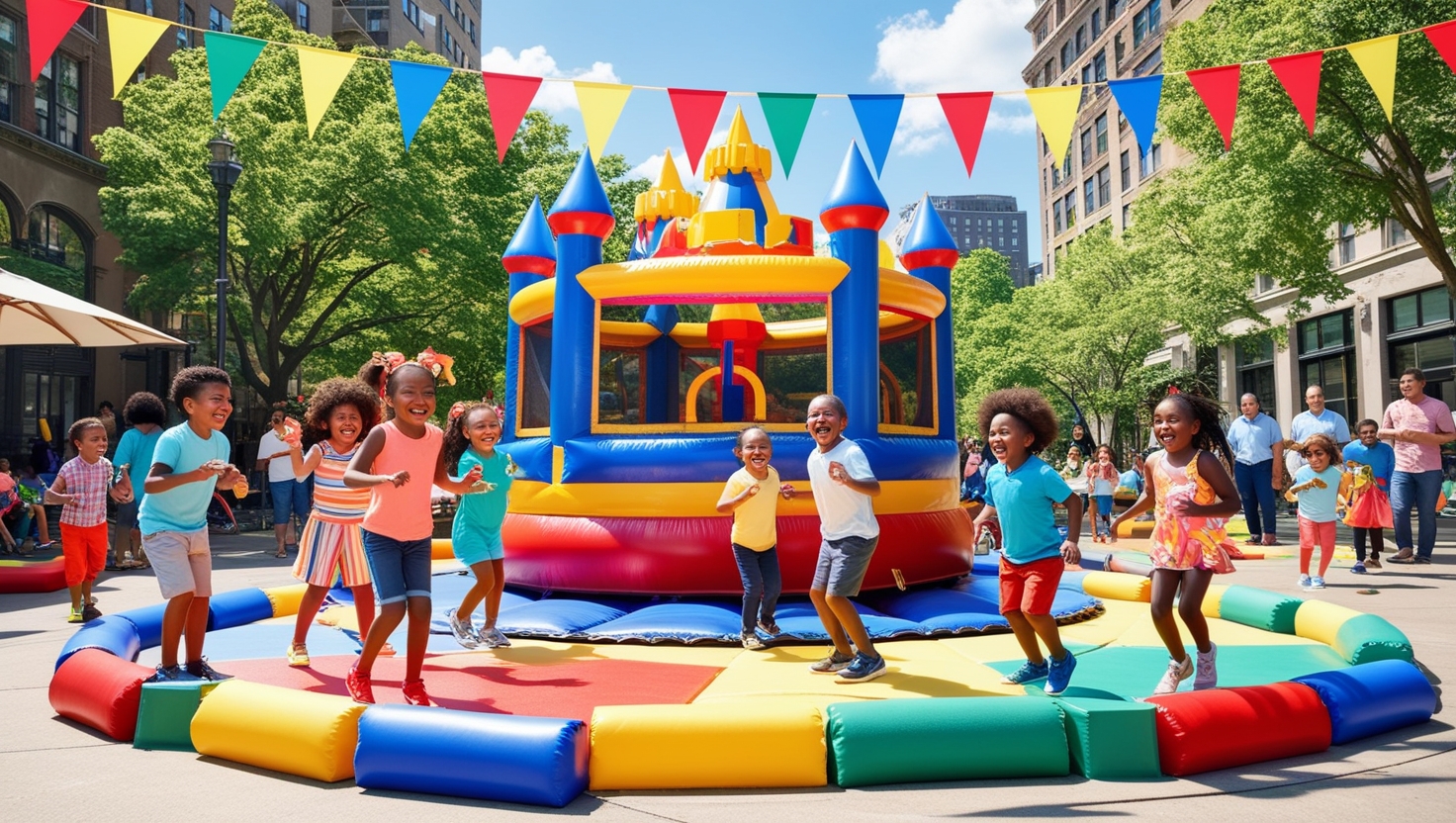
Safety Requirements for Concrete Installation
Setting up a bouncy castle on concrete requires strict adherence to safety protocols to ensure a secure and enjoyable experience. Let's explore the essential safety requirements you need to follow.
Surface Preparation
Before installation, thoroughly inspect the concrete surface for cracks, debris, or uneven areas. A clean, level surface is crucial for stability. Place thick protective mats or tarps underneath the bouncy castle to prevent direct contact with concrete and provide additional cushioning.
Anchoring System
When installing on concrete, proper anchoring becomes even more critical. Use a minimum of 40 sandbags (weighing at least 25 pounds each) or water bags strategically placed around the structure. For commercial installations, concrete anchors or thunderbolts might be necessary, following the European Standard BS EN 14960 requirements of 163kg per anchor point.
Weather Monitoring
Wind conditions are particularly important when setting up on concrete. Never operate the bouncy castle if wind speeds exceed 24mph, as concrete surfaces offer less natural resistance than grass. Keep a weather monitoring system handy and have an evacuation plan ready.
Supervision Guidelines
Maintain constant adult supervision during operation. The supervisor should be trained in emergency procedures and understand weight limits. On concrete surfaces, it's especially important to enforce strict rules about rough play and maintain appropriate occupancy limits.
Regular Safety Checks
Perform thorough safety checks every hour during operation. Inspect anchor points, look for any signs of wear on the protective matting, and ensure the blower remains securely connected. Pay special attention to areas where the structure meets the concrete surface.
Key Take away Installing bouncy castles on concrete demands rigorous safety measures, including proper surface protection, heavy-duty anchoring, constant weather monitoring, and regular safety inspections to ensure a secure environment.

Surface Preparation and Protection
When setting up a bouncy castle on concrete, proper surface preparation and protection are crucial for both safety and equipment longevity. The hard surface requires special attention to ensure a secure and enjoyable experience.
Using Protective Ground Covers
A heavy-duty tarp or specialized ground cover serves as the first line of defense between the bouncy castle and concrete. This protective layer helps prevent abrasions and wear on the inflatable's base while providing additional cushioning for jumpers.
Rubber mats offer another excellent option for surface protection. These mats are particularly effective at absorbing impact and providing extra grip, which is essential when the castle is set up on smooth concrete surfaces.
Inspecting and Cleaning the Area
Before laying any protective covering, thoroughly inspect the concrete surface for:
- Cracks or uneven areas
- Debris and sharp objects
- Oil stains or slippery substances
- Surface roughness
Clean the area meticulously to remove any particles that could damage the protective layer or the bouncy castle itself. A clean surface also ensures better grip for anchoring systems.
Creating Additional Padding
For enhanced safety, consider adding an extra layer of padding around the entrance and exit points. This provides extra protection in areas where children are most likely to make contact with the ground. Foam tiles or specialized bounce house padding can be particularly effective in these high-traffic zones.
Key TakeawayProper surface preparation with protective covers, thorough cleaning, and strategic padding is essential for safely installing bouncy castles on concrete, ensuring both equipment protection and user safety.
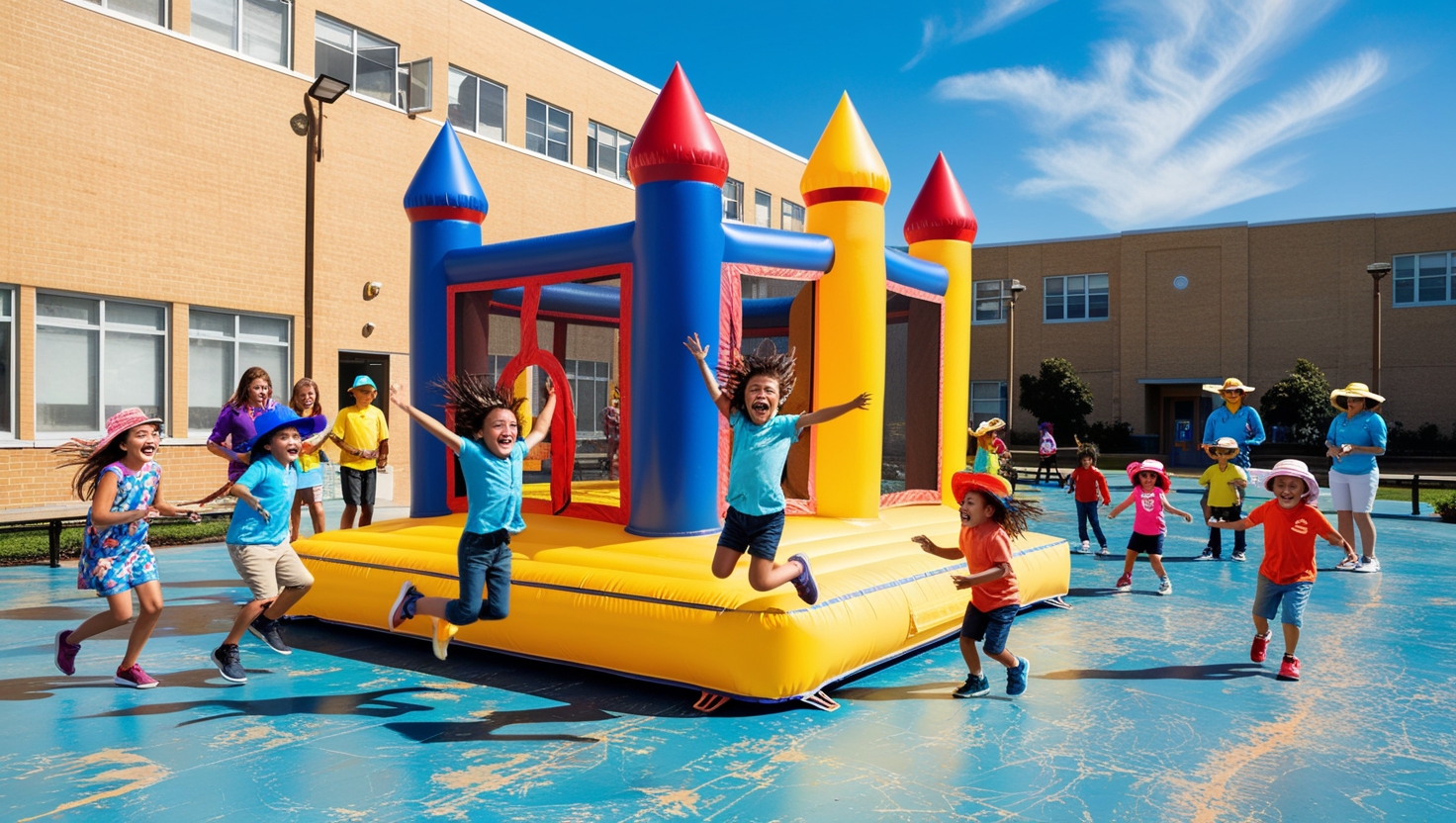
Professional Installation Guidelines
Setting up a bouncy castle on concrete requires careful attention to professional installation guidelines to ensure maximum safety. Let's explore the essential steps and precautions that professionals follow.
Surface Preparation
Before installation, thoroughly inspect the concrete surface for cracks, debris, or uneven areas. Clean the surface meticulously and lay down thick protective padding or specialized ground mats. This crucial step prevents damage to both the inflatable and the concrete while providing additional cushioning for users.
Anchoring Requirements
Professional installers use heavy-duty sandbags or water ballasts, with a minimum of 40 sandbags recommended for standard-sized bouncy castles. Each anchor point should support at least 163kg of weight according to European Standard BS EN 14960. Position anchors at all designated points, ensuring even distribution for optimal stability.
Safety Zone Setup
Establish a clear safety zone extending at least 6 feet around the entire bouncy castle. This buffer zone should be free from obstacles, sharp objects, or hard surfaces. Mark the zone clearly with safety cones or barrier tape to prevent accidents and maintain proper crowd control.
Weather Monitoring
Professional installers always check weather conditions before and during setup. Wind speeds exceeding 24mph are unsafe for bouncy castle operation on concrete surfaces. Install wind meters nearby and maintain constant monitoring throughout the event duration.
Final Safety Checks
Conduct thorough safety inspections after setup. Check all anchor points, ensure proper inflation, verify entrance/exit stability, and test emergency deflation systems. Document all safety checks and maintain a log for liability purposes.
Key TakeawayProfessional bouncy castle installation on concrete demands strict adherence to safety protocols, including proper surface preparation, adequate anchoring, and continuous monitoring to ensure a secure environment for users.
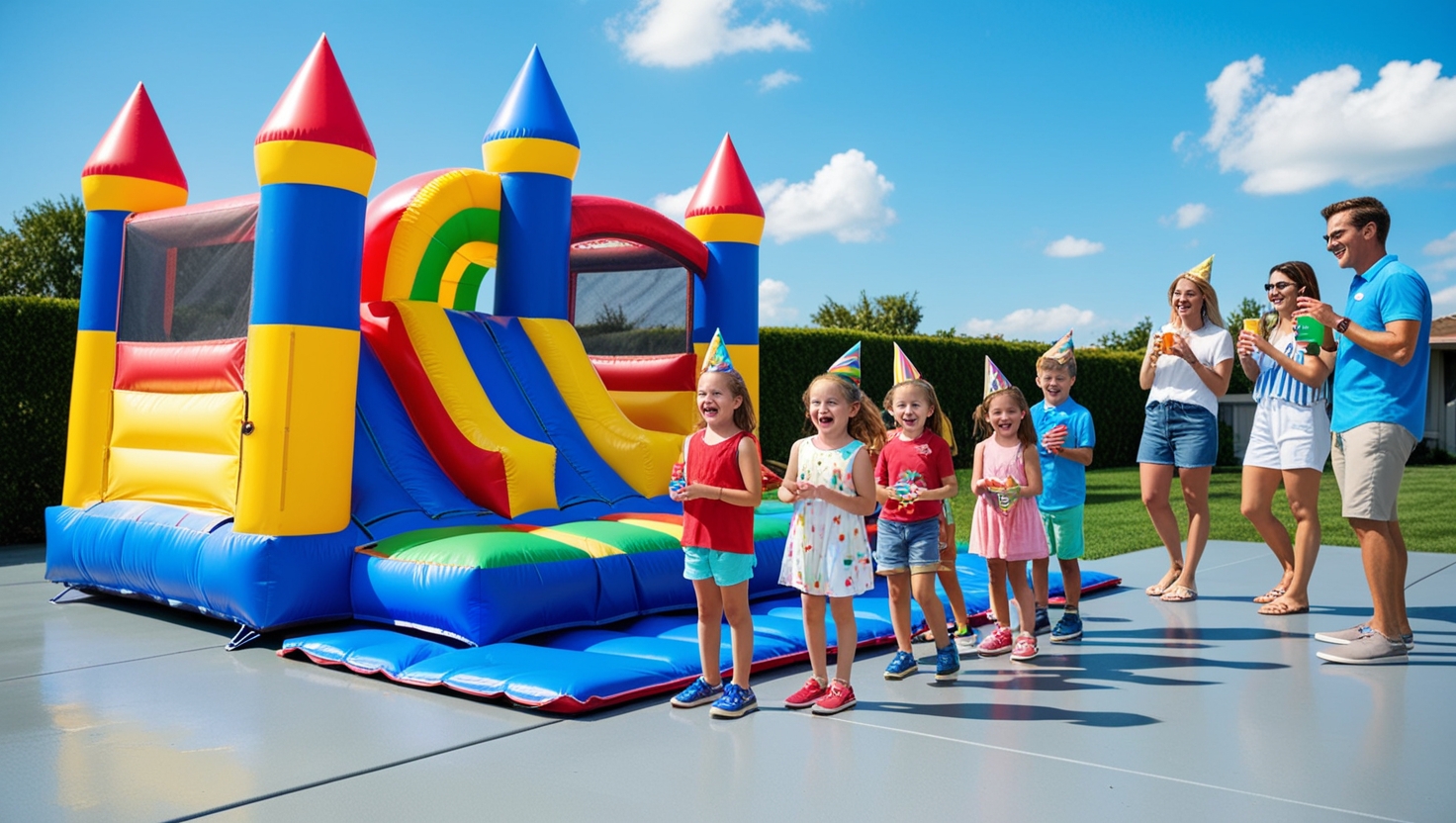
Choosing the Right Bouncy Castle for Concrete
When selecting a bouncy castle for concrete surfaces, it's crucial to prioritize specific features that ensure both safety and durability. The right choice can make a significant difference in the overall experience and longevity of your inflatable.
Material Quality
Look for bouncy castles made with heavy-duty commercial-grade PVC or Dura-Lite™ Vinyl. These materials offer superior resistance to concrete abrasion and can withstand regular use on hard surfaces. The base material should be at least 18oz in weight to ensure adequate protection.
Design Features
Select models with reinforced bottom panels and double-stitched seams. Extra padding at stress points helps prevent wear and tear from concrete contact. Consider castles with integrated anchor points specifically designed for hard surface installation.
Size Considerations
Choose a size that allows for proper anchoring on all sides. Smaller to medium-sized castles (12x12 feet to 15x15 feet) typically work best on concrete as they're easier to secure and manage. Ensure there's enough space for the required safety perimeter around the unit.
Safety Elements
Opt for models with additional safety features like higher walls, enclosed roofs, and netted sides. These elements become particularly important on concrete surfaces where falls could be more dangerous. Look for units with proper impact absorption capabilities.
Key TakeawaySelect a bouncy castle with commercial-grade materials, reinforced design features, appropriate size, and enhanced safety elements to ensure safe and durable operation on concrete surfaces.
Venue Selection and Space Requirements
When setting up a bouncy castle on concrete, careful consideration of venue selection and space requirements is crucial for safety and optimal operation. The location must be flat, level, and free from any obstructions that could pose risks to users.
Space Calculations
A typical bouncy castle requires a minimum clearance of 6 feet on all sides for safety. This buffer zone helps prevent accidents and provides easy access for supervision. For example, if your bouncy castle measures 15x15 feet, you'll need a concrete area of at least 27x27 feet.
Surface Assessment
The concrete surface must be:
- Completely level with less than 5% slope
- Free from cracks or damage
- Clean and dry
- Away from overhead obstacles
- Clear of debris and sharp objects
Location Considerations
Choose a spot that's:
- Protected from strong winds
- Away from power lines
- Easily accessible for emergency services
- Close to restroom facilities
- Within view of supervision areas
Remember to check local regulations regarding outdoor inflatable setups, as some areas may have specific requirements for concrete installations.
Key TakeawaySuccessful bouncy castle setup on concrete requires careful venue selection with adequate space, level surface, and strategic positioning for optimal safety and accessibility.
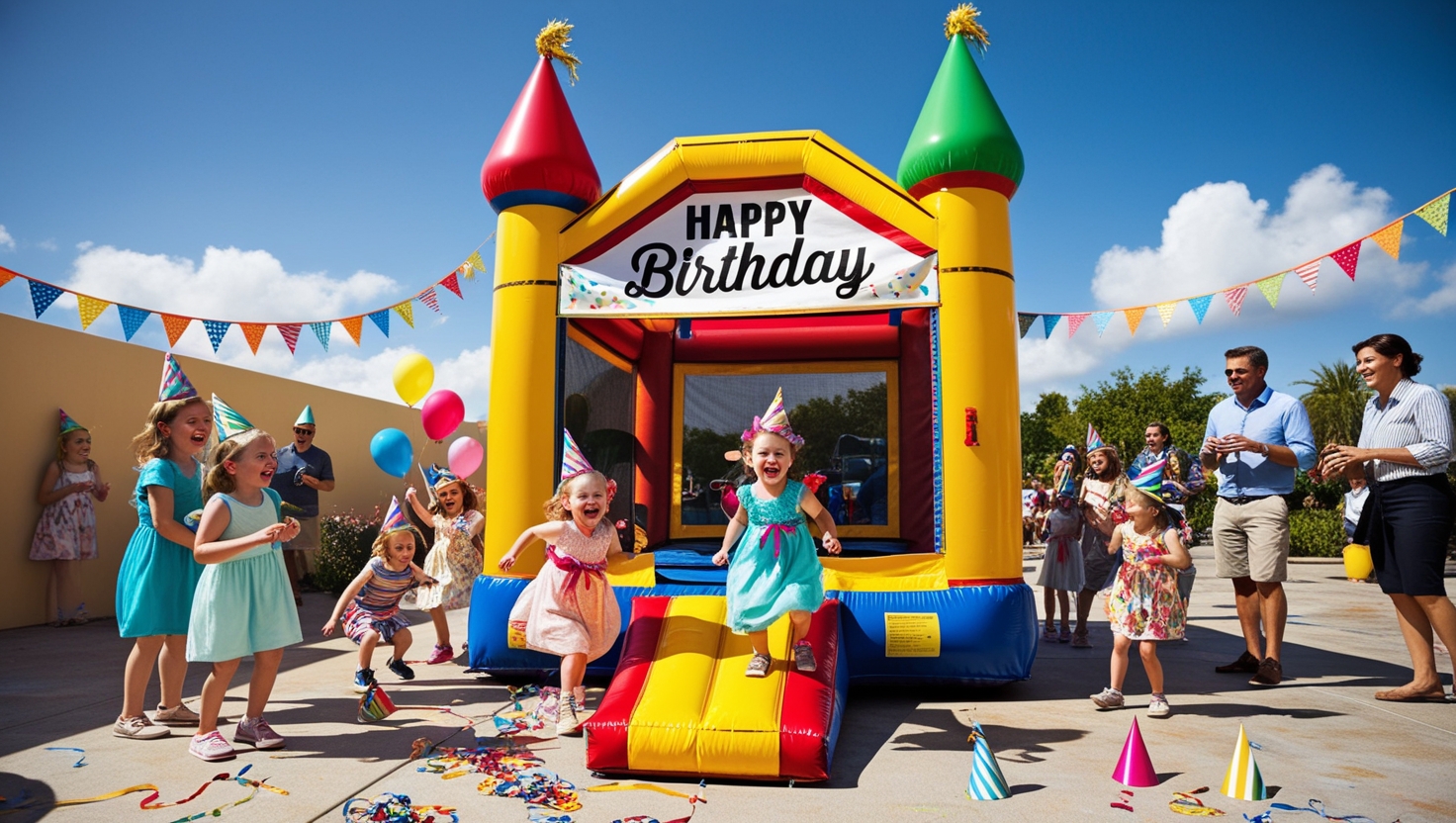
Maintenance and Care on Concrete Surfaces
Proper maintenance is crucial when operating bouncy castles on concrete surfaces to ensure both safety and longevity. Regular inspections before, during, and after use help identify potential wear and tear issues early.
Daily Cleaning Protocol
Sweep the concrete surface thoroughly before setup to remove any debris or sharp objects. After each use, clean the inflatable with a mild soap solution and dry it completely to prevent mold growth.
Surface Protection Measures
Always place a thick tarp or specialized ground mat between the bouncy castle and concrete. This not only protects the inflatable's base but also provides additional cushioning for users.
Regular Inspection Points
- Check anchor points and straps for signs of stress
- Examine seams and stitching for potential tears
- Inspect blower connections and vents
- Monitor the concrete surface for any developing cracks
Storage Considerations
When not in use, store the bouncy castle in a dry, climate-controlled environment. Avoid folding the inflatable while damp, as this can lead to mildew and material degradation.
Key TakeawayRegular maintenance, proper cleaning, and protective measures are essential for bouncy castles on concrete surfaces to ensure safety and extend equipment lifespan.

Risk Management and Safety Protocols
When setting up a bouncy castle on concrete, implementing robust safety measures is crucial. Proper risk management ensures both the safety of users and compliance with regulations.
Regular Safety Inspections
Conduct thorough inspections before and during operation. Check for any tears, loose seams, or damaged anchor points. Monitor the inflation levels and ensure all blowers are functioning correctly. Pay special attention to areas where the castle makes contact with the concrete surface.
Weather Monitoring
Keep a close eye on weather conditions, particularly wind speeds. Operations should cease immediately if winds exceed 24mph. Install an anemometer nearby to accurately measure wind velocity. Have an evacuation plan ready in case of sudden weather changes.
Supervision Guidelines
Maintain constant adult supervision during operation. Establish clear rules about maximum occupancy, age restrictions, and prohibited behaviors. Train supervisors on emergency procedures and proper user management techniques.
Emergency Response Plan
Develop and communicate a clear emergency protocol. Keep first aid supplies readily available and ensure supervisors are trained in basic first aid. Have emergency contact numbers visible and establish clear evacuation routes.
Documentation Requirements
Maintain detailed records of all safety checks, incidents, and maintenance activities. Keep copies of insurance certificates and inspection reports on-site. Document any safety briefings given to supervisors or users.
Key TakeawayEffective risk management for bouncy castles on concrete requires regular inspections, weather monitoring, constant supervision, clear emergency protocols, and proper documentation to ensure safe operation.

Professional Rental Tips
Choosing a Reputable Provider
When renting a bouncy castle for concrete setup, select companies with proper insurance coverage and safety certifications. Ask about their experience with concrete installations and verify they follow industry standards for anchoring and setup.
Equipment Inspection
Before signing any rental agreement, thoroughly inspect the bounce house for wear and tear. Check the bottom material for durability and ensure all anchor points are intact. Request information about the protective materials they provide for concrete setups.
Clarify Setup Requirements
Discuss specific requirements for concrete installation with the rental company. Confirm they provide adequate anchoring equipment like sandbags or water ballasts. Most professional companies recommend using at least 40 sandbags for secure installation.
Weather Considerations
Work with rental companies that have clear weather policies. Many won't install on concrete if wind speeds exceed 24mph. Ensure they provide guidance on weather-related safety protocols and have clear cancellation policies.
Insurance and Liability
Verify the rental agreement includes liability coverage for concrete installations. Some companies may require additional insurance or waivers. Always read and understand the terms before signing any contracts.
Key TakeawayChoose rental companies with concrete installation experience, proper insurance, and comprehensive safety protocols. Ensure they provide adequate anchoring equipment and clear weather policies for safe operation.
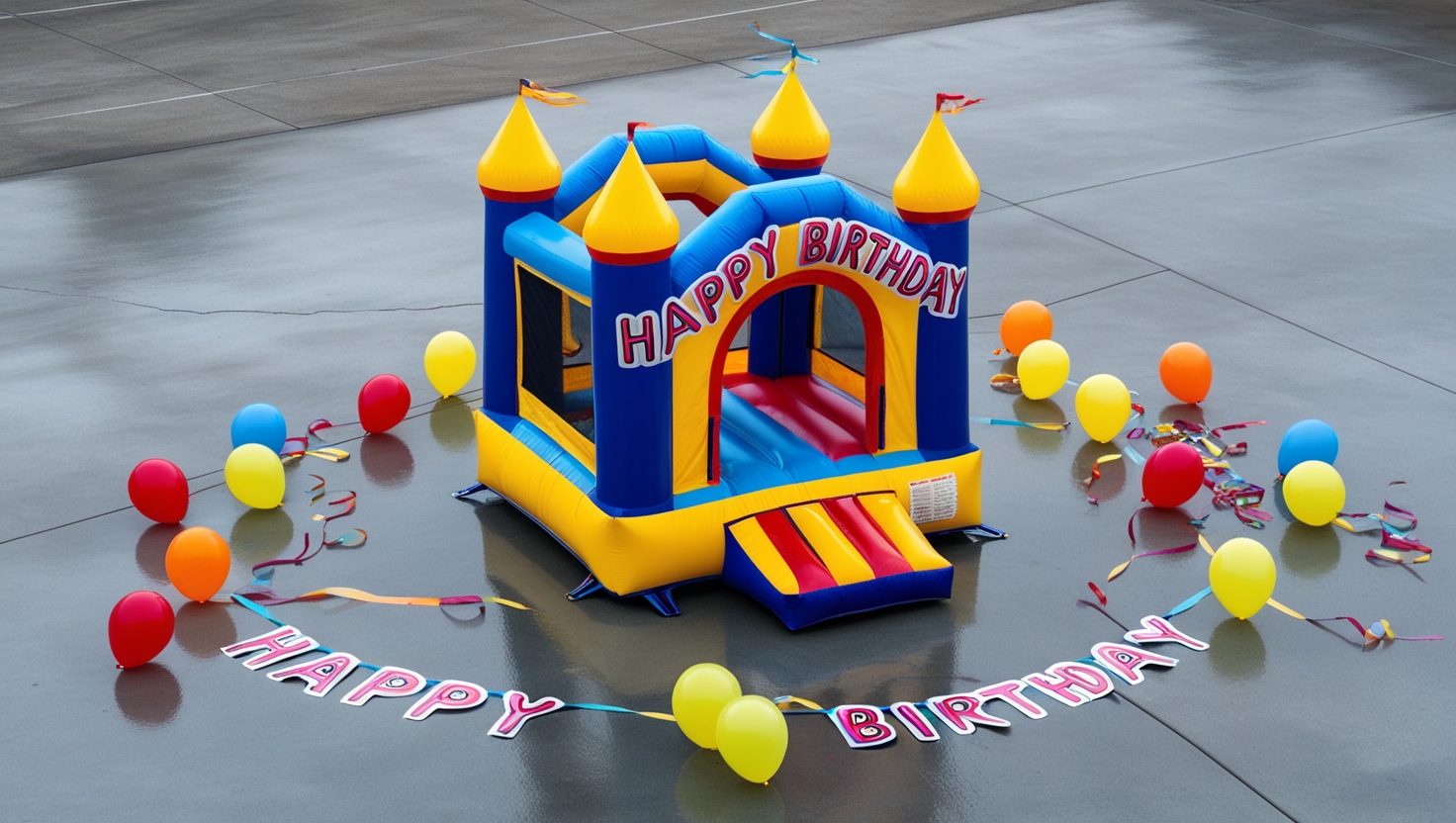
Conclusion
Setting up a bouncy castle on concrete is entirely feasible when you prioritize safety and follow proper installation guidelines. By implementing protective ground covers, using appropriate anchoring systems, and adhering to weight limitations, you can create a secure environment for children to enjoy their bouncing adventures. Remember to always check weather conditions, particularly wind speeds, and ensure all safety measures are in place before allowing children to play. Regular maintenance checks during operation and proper supervision are crucial for preventing accidents and ensuring an enjoyable experience for all participants. Whether you're planning a birthday party, community event, or special celebration, don't let concrete surfaces deter you from creating memorable moments. With the right preparation and attention to safety details, your bouncy castle setup can be both secure and entertaining. Take action today by connecting with reputable rental companies who understand these safety protocols and can help you create the perfect bounce house experience on concrete surfaces.
FAQs
Can bouncy castles be used indoors on concrete floors?
Yes, bouncy castles can be safely used indoors on concrete floors. Ensure proper padding underneath, adequate ceiling height, and secure anchoring. Indoor use eliminates wind concerns and provides better temperature control. Always follow the manufacturer's guidelines for indoor setup.
What wind speed is considered unsafe for bouncy castle operation?
Bouncy castles should not be operated when wind speeds exceed 24mph (38km/h). It's a strict legal requirement to monitor wind conditions. For safety, deflate and secure the castle if wind speeds approach this limit or if strong gusts are forecasted.
How much weight can a typical bouncy castle support on concrete?
A standard bouncy castle can typically support 600-1000 pounds, depending on size and manufacturer specifications. Weight should be evenly distributed, and the number of simultaneous users should be limited based on age and size to maintain safety standards.
What type of padding is best to use under a bouncy castle on concrete?
High-density foam mats or specialized bounce house padding are ideal for concrete surfaces. The padding should be at least 1.5 inches thick and extend 6 feet beyond the bounce house edges. Interlocking foam tiles also work well for surface protection.
How often should bouncy castles be inspected when used on concrete?
Bouncy castles require inspection before each use, during operation (every 1-2 hours), and after dismantling. Check for wear on contact points with concrete, ensure padding remains in place, and verify anchor points are secure throughout operation.
What's the minimum space needed around a bouncy castle for safety?
A minimum clearance of 6 feet is required on all sides of the bouncy castle. For concrete installations, ensure this space is free from obstacles, has proper padding, and maintains clear access to entrance/exit points for emergency situations.